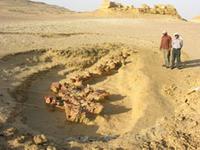
Completed excavation of the skeleton of 18-meter long whale Basilosaurus isis in the Western Desert of Egypt as exhibited last week by University of Michigan and Egyptian Environmental Affairs Agency paleontologists. Photo: Philip GingerichUniversity of Michigan paleontologist Philip D. Gingerich and colleagues at the Egyptian Environmental Affairs Agency (EEAA) announced April 10 the successful excavation of an unusually complete and well-preserved skeleton of the 40 million-year-old fossil whale Basilosaurus isis.
The new skeleton is 18 meters (50 feet) long and was found in Wadi Hitan in the Western Sahara of Egypt. The first Basilosaurus fossil was found in 1905 but no full skeleton has been discovered until now.
The new skeleton of Basilosaurus will be shipped to Michigan for preparation and preservation, Gingerich said, via email. It then will be replicated in a casting material suitable for reconstruction and exhibition of the complete skeleton. The original fossil bones and a complete cast will be returned to Egypt for exhibition in public museums in Cairo and in the Wadi Hitan visitors center. Gingerich also hopes that a complete cast can be mounted in the University of Michigan Exhibit Museum.
The fossil whales of Wadi Hitan were first mapped in the 1980s and 1990s during expeditions led by Gingerich, a professor at the U-M Museum of Paleontology and Department of Geological Sciences. The 1989 team discovered that Basilosaurus still retained tiny, useless legs, feet, and toes representing hind legs that were lost at a later stage of whale evolution. No skeleton was collected at the time because of the remote location of Wadi Hitan and because of the large size of the whale skeletons.

Line drawing: Hans Theweissen
Wadi Hitan is a remote valley in which hundreds of fossil whale skeletons are being exposed by the wind. They lie trapped in a sandstone formation that represents an ancient sea bed. "Here the wind sculpts the sand into spectacular shapes, which give the valley an unusual beauty in addition to its richness in fossils," Gingerich said.
Wadi Hitan is a protected area administered by EEAA and is being developed as a national park by an Italian-Egyptian cooperative program. It also has been nominated as a UNESCO World Heritage Site because of its natural beauty and scientific importance.
Sea-living animals found in the Wadi Hitan desert include five species of whales, including the Dorudon atrox, presently exhibited in the University of Michigan Exhibit Museum. There are also three species of sea cows (Sirenia), two crocodiles, several turtles, and a sea snake, in addition to a large number of fossilized sharks and bony fishes.
This latest discovery is expected to enhance education about whales and geological history in Egypt. It will also help in developing and publicizing the network of national parks in Egypt, where President Hosni Mubarak is emphasizing preservation of natural resources by providing support for conservation of the natural environment.
"Basilosaurus is an enigma of whale evolution because of its unusually long serpentine body," Gingerich said. "The research team will use the new skeleton to study how it lived and swam, and possibly to learn why it is so abundant in Wadi Hitan."
The field research group working in Egypt now is led by Gingerich and includes doctoral student Iyad S. Zalmout of the University of Michigan department of geological sciences, Mohamed Sameh M. Antar and Gebely Abu el Khair of EEAA, and a team of eight assistants, all operating from a remote desert camp.
Field study of the fossil whales of Wadi Hitan is sponsored by the National Geographic Society and by the University of Michigan Office of the Vice-President for Research.
Source (text and images) : University of Michigan
 Print Article
Print Article Mail to a Friend
Mail to a Friend
